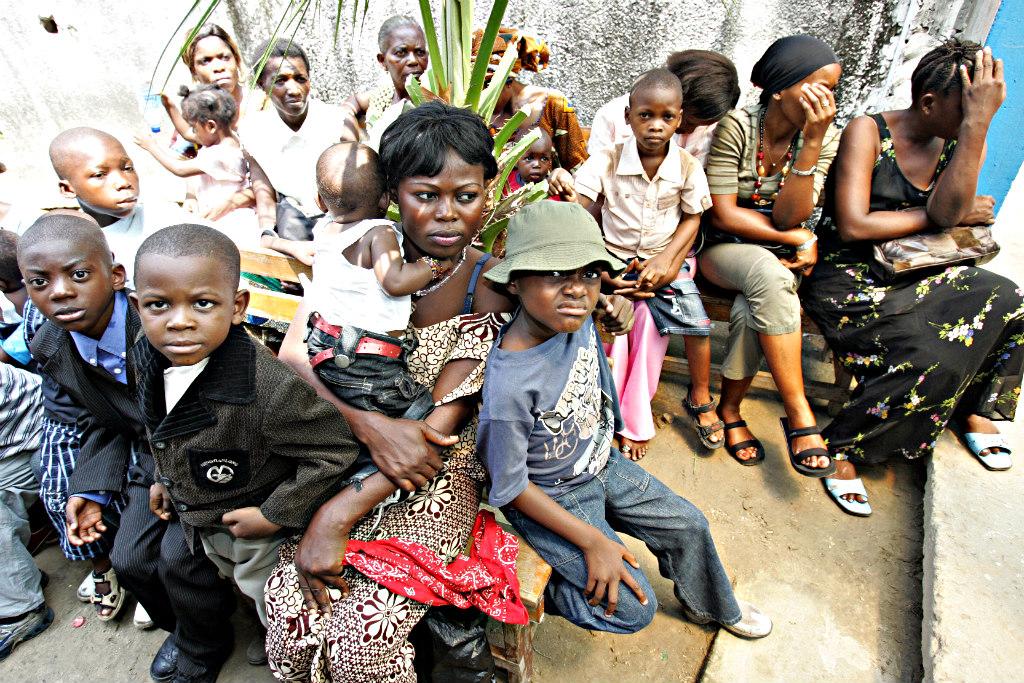UN: Millennium Development Goals leaving some regions behind
Mothers and children wait to meet the United Nations Secretary General Ban Ki-Moon at Kalembelembe Pediatric center in Kinshasa, Democratic Republic of the Congo. Ban Ki-Moon said he chose the DRC to start his African tour to ‘pay tribute to the courage and determination of the Congolese people.’
The United Nations praised progress made around the world toward achieving the eight Millennium Development Goals (MDGs) in an official report released today. Targets for reducing poverty, increasing access to clean water and ensuring environmental sustainability have already been reached in advance of the 2015 deadline, and others are on their way to being achieved, according to the Millennium Development Goals Report 2014.
But the UN, along with human rights groups, said that the results are uneven and called for continued efforts to fight disease, pollution and inequality. More attention should be given to regions such as South Asia, sub-Saharan Africa and Oceania, where conflict, underdeveloped rural areas, continuous population growth and economic volatility have made for slower growth, they said.
“The concerted efforts of national governments, the international community, civil society and the private sector have helped expand hope and opportunity for people around the world,” UN Secretary-General Ban Ki-Moon wrote in the report’s foreword. “But more needs to be done to accelerate progress. We need bolder and focused action where significant gaps and disparities exist.”
Four of the eight MDGs – those seeking to eradicate extreme hunger and poverty, promote universal primary education, preserve environmental sustainability and build a global partnership for development – have already been achieved or are close to being achieved, particularly in east and central Asia, Latin America and the Caribbean and northern Africa, according to the new report. Health-related goals have been harder to attain, however, as many regions continue to struggle with improving maternal health, fighting disease and reducing child mortality.
“I think the MDGs have brought us much further than most people imagined that we would get,” said Joanne Carter, executive director of RESULTS, an anti-poverty advocacy group based in Washington, D.C. “Is it enough? No.”
“We’ve seen really mixed progress across the MDGs,” said Erin Hohlfelder, global director of health policy at ONE, an international nonprofit advocating for the end of extreme poverty and preventable disease.
While there’s a lot to celebrate in some areas targeted by the goals, Holhlfelder said, others have seen only incremental progress – and geographical disparities persist.
For instance, the MDGs set out to reduce the poverty rate in developing countries by half from the 1990 level, which was nearly 50 percent of the population. It has dropped to about 22 percent in 2010, according to the UN report. But one in five people still survives on less than a dollar a day, and more than half the world’s extreme poor still live in India, Nigeria, Bangladesh and the Democratic Republic of Congo.
Millennium Development Goal 4 sought to reduce the mortality rate of under-five-year-olds by two-thirds. But despite the 14 million deaths averted between 2000 and 2012 due to measles vaccinations, preventable diseases are still the main cause of death for children under five. Sub-Saharan Africa bore the brunt of the world’s newborn deaths at more than 3 million in 2012 alone, and was also the only region where the number of undernourished children increased between 1997 and 2012.
Rural districts also lag behind metropolitan areas in maternal health care and sanitation, MDGs 5 and 7: More than 80 percent of births not attended by a skilled health worker in 2012 occurred outside of a city, and seven out of 10 people without access to upgraded sanitation facilities live in rural areas.
And MDG 6 sought to stop and begin to reverse the spread of HIV/AIDS and tuberculosis. While antiretroviral therapy has saved more than 6 million lives since 1995, HIV remains an crisis in areas of sub-Saharan Africa, where 70 percent of new infections in 2012 occurred. The same goes for tuberculosis, which has seen a slow rate of decline and continues to place young children and pregnant women at high risk in countries such as Nigeria.
Apart from these disparities, the UN report also noted other challenges to achieving the MDGs such as shifting trends in donor assistance, partly due to the global financial crisis. Aid is moving away from the least developed countries towards middle-income ones – a big problem for regions such as Africa, where such resources are crucial.
Data collection is another issue, according to the report. Millions of children are born without a birth certificate, denying them access to proper care and social security. And institutional, financial and political hurdles continue to stifle the flow of key information, especially in unstable regions.
Still, advocates remain cautiously optimistic and confident that the lessons learned from developing and working toward the MDGs will inform future efforts.
“I think most people understand that to achieve all of the MDGs is not realistic,” Hohlfelder said. “What will be interesting to see, even if we don’t achieve it all across the board, is which countries will be making accelerated progress.”
The last two decades, Carter said, have taught the international community not only how to map out the process of achieving their goals, but also how to accelerate that process – both of which will inform the UN’s plans for post-2015.
“One real lesson from the MDGs is the power of … focusing on a relatively small number of high-priority goals,” she said. The strategy allows for a concentration of resources and political will on specific, achievable targets, which, Carter noted, helped countries such as Ethiopia and Rwanda make incredible headway. Both are on track for achieving almost all the MDGs.
This type of progress should give the international community hope, Carter said. That’s because those who rallied together around the MDGs now know what it takes “to get to the endgame.”
More from GlobalPost: Millennium Development Goals: When failure means success
